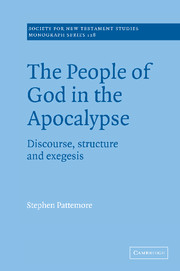Book contents
- Frontmatter
- Contents
- List of figures and table
- Preface
- List of abbreviations
- 1 A question of relevance
- 2 Relevance Theory in biblical interpretation
- 3 A cognitive environment for the Apocalypse
- 4 Souls under the altar – a martyr ecclesiology
- 5 Companions of the Lamb – a messianic ecclesiology
- 6 The New Jerusalem, bride of the Lamb
- 7 Summary and conclusions
- Appendix: Abbreviated discourse outline
- Bibliography
- Index
3 - A cognitive environment for the Apocalypse
Published online by Cambridge University Press: 22 September 2009
- Frontmatter
- Contents
- List of figures and table
- Preface
- List of abbreviations
- 1 A question of relevance
- 2 Relevance Theory in biblical interpretation
- 3 A cognitive environment for the Apocalypse
- 4 Souls under the altar – a martyr ecclesiology
- 5 Companions of the Lamb – a messianic ecclesiology
- 6 The New Jerusalem, bride of the Lamb
- 7 Summary and conclusions
- Appendix: Abbreviated discourse outline
- Bibliography
- Index
Summary
Introduction
A Relevance-Theoretic approach to understanding the Apocalypse locates meaning not within the text alone, but in the interaction of the text with the context of the reader/hearer in order to optimize relevance. If we are to follow the interpretive steps of the first readers, then, we shall need to know as much as possible about the cognitive environment within which they received the text. But we shall also need to understand how the structure of text provided for any given passage a text-internal context, and a series of natural connections to other passages. These two dimensions of context, the external and the internal, are the focus of this chapter and will be treated in quite different ways. First we shall state the assumptions we make about the text-external context, and then we shall report the results of a relevance-guided study of the discourse structure of the book.
The text in its context
Relevance Theory insists that context is not a fixed, predetermined construct, but is created progressively as the communication proceeds. Nevertheless, it is necessary to make some initial assumptions about the location of the text in social and historical terms, assumptions which can then be drawn on as possible elements of the mutual cognitive environment for a given passage. I shall state, then, as concisely as possible the background assumed for the text of Revelation, and elaborate briefly on a number of significant points.
The book of Revelation is the record of a communication from a prominent individual, John, intended to be read aloud to gatherings of mixed Jewish–Gentile Christian communities in Asia Minor in the last decade of the first century AD. […]
- Type
- Chapter
- Information
- The People of God in the ApocalypseDiscourse, Structure and Exegesis, pp. 51 - 67Publisher: Cambridge University PressPrint publication year: 2004



